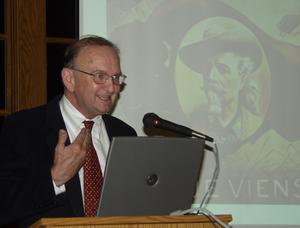Sandoz Society Conference opens at Chadron State

The image of the American bison, or buffalo, was portrayed as a reflection of how the American public was thinking as the annual meeting of the Mari Sandoz Heritage Society opened at Chadron State College on Thursday.
The keynote speaker was Dr. Elliott West, an author of several books dealing with the frontier and a history professor at the University of Arkansas. He called the buffalo a cultural icon, noting that it is distinctive to America, but has been a bizarre commodity.
West noted that that the buffalo created great problems for the early European visitors who tried to describe it for the folks back home who had never seen anything quite like it. One writer depicted it as a creature with hips and haunches like those of a hog, the size of cattle, but hair like goats and the fierce expression of a wild boar. A Spaniard described it as horse-like, tail tufted like a lion, with the hump of a camel.
English descriptions included shag-haired oxen, wild cattle and prairie beeves, West said. He added that many agreed it was available for profit because it provided both good food and hides for leather.
In the early 19th century, West said the bison emerged as the central symbol of the American West. During his power-point presentation, West showed numerous paintings of buffalo being hunted by Indians on horseback. He said the animal became associated with the vastness and freedom of the American frontier, and claimed that these scenes helped develop the identity that the nation was blessed with a magnificent wilderness waiting to be conquered and civilized.
Ironically, the implementation of the latter notion also caused the demise of the buffalo. During the latter decades of the 1800s, buffalo were killed by the thousands, the hides removed and sold for profit, the meat left to rot and the prairie became strewn with bleached bones.
Somehow, West pointed out, William F. (Buffalo Bill) Cody was able to emerge from this scenario as a folk hero. The speaker called Cody “the most fascinating personality in the American popular culture in the late 19th century.”
“Buffalo Bill was a symbol of the wild and free West, and also a harbinger of civilization,” the Arkansas professor said.
Ironically, those who followed Cody in slaughtering buffalo were some of the most vilified characters in American history. West noted that somehow the mountainmen who came West to trap beaver for their pelts were romanticized while the buffalo hunters were seen as greedy and destructive misfits. The scenes now showed filthy men skinning bloated animals or a landscape with rotting carcasses.
In a short time, West said the bison went from being a symbol of the nation’s romantic identity to one of the dark industrial age that loomed ahead.
Bolstered by movies such as “Dances with Wolves” and the fact that prominent Americans such as Ted Turner and Ralph Lauren are raising buffalo in vast numbers, West said the buffalo has made a great comeback. He said it is again a popular symbol in America, providing food that is low in fat and cholesterol, but high in protein.
Category: Campus News
